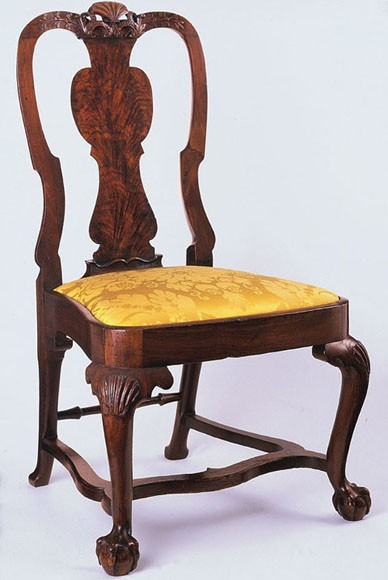
Side chair with carvings attributed to John Welch, Boston, ca. 1735. Walnut and walnut veneer with maple and white pine; maple slip seat. H. 38 5/8", W. 20 3/4", D. 18 1/2". (Courtesy, The Metropolitan Museum of Art, gift of Mr. and Mrs. Benjamin Ginsburg, 1984 (1984.21) All rights reserved, The Metropolitan Museum of Art; photo, Gavin Ashworth.)
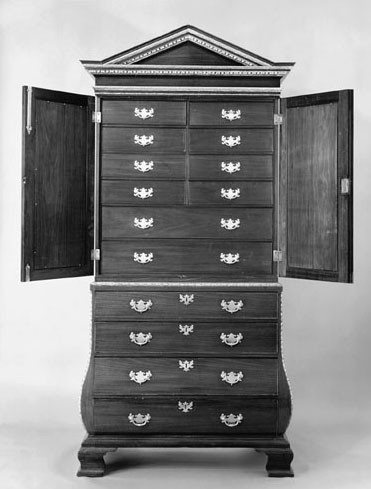
Bureau with cabinet, London, 1740–1750. Mahogany, partially gilded, mahogany veneered on oak, deal, brass.. H. 97", W. 46 3/4", D. 25 1/2". (Courtesy, Museum of Fine Arts, Boston. Reproduced with permission. ©2000 Museum of Fine Arts, Boston. All rights reserved. Gift of Albert Sack.) This bureau is related to case pieces attributed to the shop of London cabinetmaker Giles Grendy, one of the leading exporters of furniture.

Side chair, London, 1725–1735. Walnut and walnut veneer. (Photograph Courtesy of Sotheby’s, Inc. ©2002)

John Singleton Copley, Jeremiah Lee, Boston, ca. 1770. Oil on canvas. Frame attributed to John Welch, Boston, ca. 1767. White pine, gilded. Portrait dimensions: 95" x 59". (Courtesy, Wadsworth Atheneum, Ella Gallup Sumner and Mary Catlin Sumner Collection Fund.)

Detail of the crest rail carving on the side chair illustrated in fig. 1. (Courtesy, The Metropolitan Museum of Art, gift of Mr. and Mrs. Benjamin Ginsburg, 1984; All rights reserved, The Metropolitan Museum of Art; photo, Gavin Ashworth.)

Detail of the shell and acanthus carving on the frame illustrated in fig. 4.
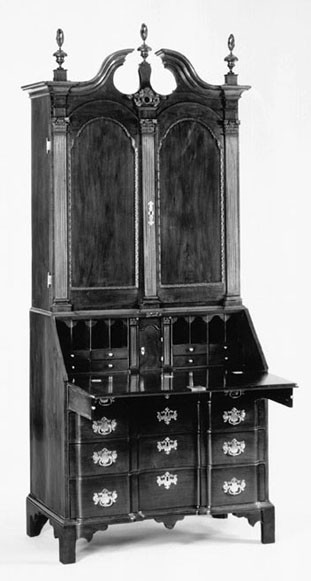
Desk-and-bookcase with carving attributed to John Welch, Boston, 1750–1755. Mahogany with white pine. H. 95 1/2", W. 40", D. 22". (Courtesy, Saint Louis Art Museum, Museum Shop Fund; photo, Christie’s.)
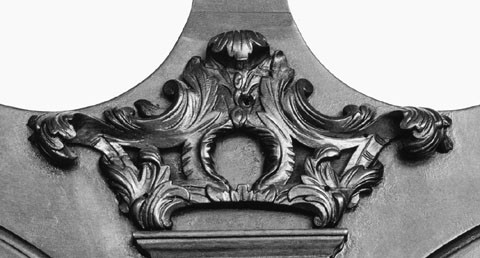
Detail of the scrollboard appliqué of the desk-and-bookcase illustrated in fig. 7. (Photo, Christie’s.)
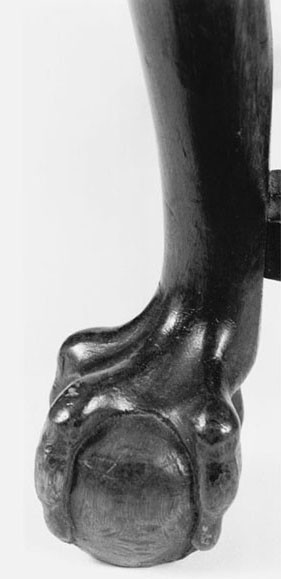
Detail of the foot of the side chair illustrated in fig. 1. (Courtesy, The Metropolitan Museum of Art, gift of Mr. and Mrs. Benjamin Ginsburg, 1984; All right reserved, The Metropolitan Museum of Art; photo, Gavin Ashworth.)

Diagram of (a) diagonal orientation with foot placed in center of stock and toes at corners; (b) diagonal orientation but with foot placed at front corner; (c) frontal orientation with knee blocks on opposite sides (see legs of turret table illustrated in fig. 13). (Drawing, Alan Miller; artwork, Wynne Patterson.)

Card table with carving attributed to John Welch, Boston, 1730–1740. Mahogany with white pine. H. 28 3/4", W. 31 3/4", D. 16". (Private collection; photo, Wit McKay.) A label in the table reads, “1906 . . . This . . . card table belonged to Peter Roe Dalton, Jnr. . . . Descended to his son Peter Roe, Jnr., was in his house-72 Boylston Street.” A Boston bombé chest descended in the same family.

Detail of the foot of the card table illustrated in fig. 11. (Photo, Wit McKay.)

Card table with carving attributed to John Welch, Boston, 1740–1755. (Private collection; courtesy, John Walton Antiques.) This card table has claw-and-ball feet that are very similar to those of the chair illustrated in fig. 16. These feet are typical of those produced in Welch’s shop during the 1740s and early 1750s.
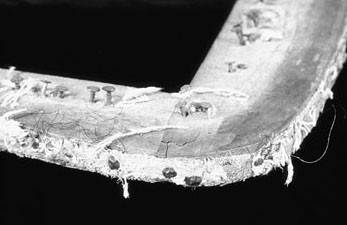
Detail of the slip seat of a chair from the Apthorp suite.

Easy chair with carving attributed to John Welch, Boston, 1730–1740. Walnut and maple. H. 44", W. 31", D. 22". (Courtesy, Winterthur Museum.) The stretchers have a coved outer edge like those on the Apthorp chairs.

Side chair with carving attributed to John Welch, Boston, 1740–1750. Walnut and walnut veneer with maple and white pine; maple slip seat. H. 38 1/2", W. 22", D. 18 3/8". (Courtesy, Brooklyn Museum; photo, Gavin Ashworth.) The veneer on the splats of these chairs appears to be from the same flitch as those of the set including the chair illustrated in fig. 21.

Detail of the knee carving on the side chair illustrated in fig. 16. (Photo, Gavin Ashworth.)

Detail of the knee carving on the side chair illustrated in fig. 1. (Courtesy, The Metropolitan Museum of Art, gift of Mr. and Mrs. Benjamin Ginsburg, 1984; All rights reserved, The Metropolitan Museum of Art; photo, Gavin Ashworth.)
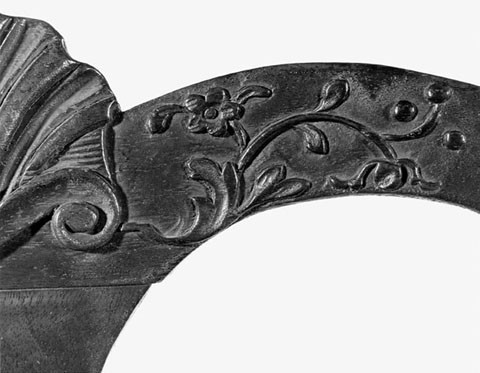
Detail of the crest rail carving on the side chair illustrated in fig. 16. (Photo, Gavin Ashworth.)
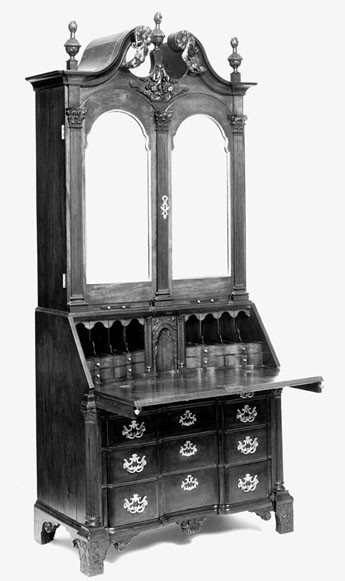
Desk-and-bookcase with carving attributed to John Welch, Boston, 1743–1748. Mahogany and sabicu with red cedar and white pine. H. 97 1/4", W. 42 7/8", D. 23 1/4". (Courtesy, Winterthur Museum.)
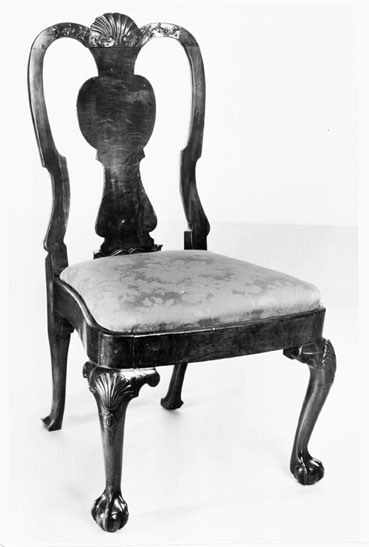
Side chair with carving attributed to John Welch, Boston, 1740–1750. Walnut and walnut veneer. H. 38", W. 20 1/2", D. 18 1/8". (Courtesy, Bernard & S. Dean Levy, Inc., NYC.)

High chest with carving attributed to John Welch, Boston, 1740–1750. Mahogany with white pine. H. 95 1/8", W. 41 1/4", D. 22 1/8". (Courtesy, Collection of Dorothy McIlvain Scott, Promised Gift to the Baltimore Museum of Art.)

Detail of the appliqué on the desk-and-bookcase illustrated in fig. 20.
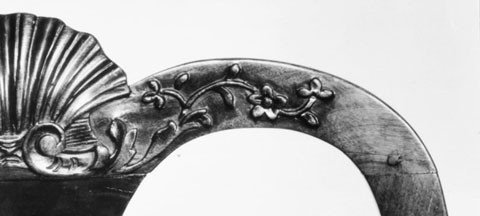
Detail of the crest rail carving on a chair from the same set as the chair illustrated in fig. 21. (Photograph Courtesy of Sotheby’s, Inc. ©2002.) The acanthus leaves emanate from the scroll volutes like those on the appliqué of the desk-and-bookcase illustrated in fig. 23. Both carvings have chip cuts in the scroll hollows and similar arrangement of the leaf elements.
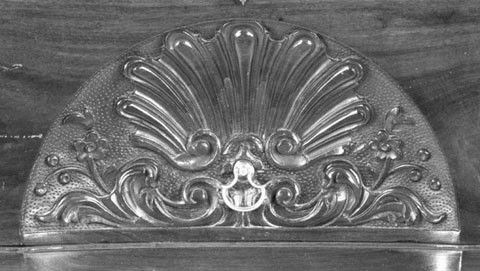
Detail of the lower drawer of the high chest illustrated in fig. 22.
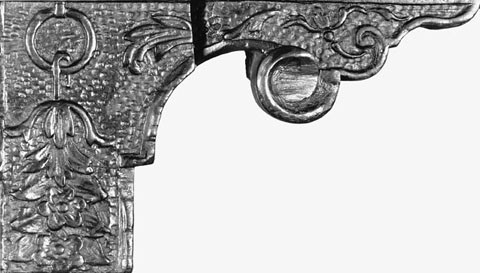
Detail of the foot of the desk-and-bookcase illustrated in fig. 20. The relief-carved husks (one rising from the edge beading and the other hanging from the loop) are products of the same design vocabulary, tool kit, and working style as the corresponding husks on the crest rails of the chairs illustrated in figs. 16 and 21 and the shell drawer illustrated in fig. 25.

Tall case clock with carving attributed to John Welch, Boston, 1750. Mahogany with white pine and courbaril. H. 100". (Courtesy, © The Art Institute of Chicago. All rights reserved. Alyce and Edwin DeCosta and Walter E. Heller Foundation and Harold Stuart Endowments; photo, Sotheby’s.)
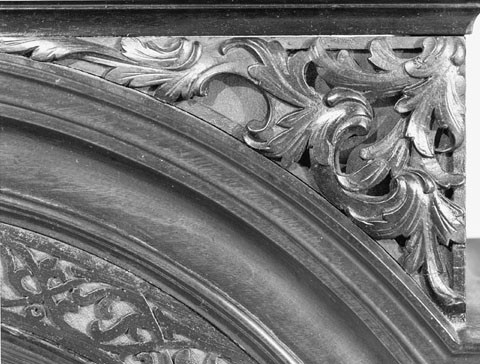
Detail of a spandrel appliqué on the tall clock case illustrated in fig. 27.

Side chair with carving attributed to John Welsh, Boston, 1735–1745. Walnut and walnut veneer with maple; maple slip seat. H. 39 1/2", W. 21 3/4". (Courtesy, Museum of the City of New York, gift of Mrs. Screven Lorillard.) www.mcny.org

Side chair with carvings attributed to John Welch, Boston, 1735–1745. Walnut with white pine; maple slip seat. H. 40", W. 20 1/2", D. 18 1/2". (Courtesy, The Metropolitan Museum of Art, Rogers Fund, 1925 (25.115.11) All rights reserved, The Metropolitan Museum of Art; photo, Gavin Ashworth.)
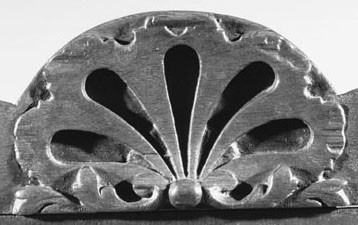
Detail of the crest rail carving on the side chair illustrated in fig. 30. The missing tips of the shell resembled those of the shell illustrated in fig. 32. (Courtesy, The Metropolitan Museum of Art, Rogers Fund, 1925 All rights rreserved, The Metropolitan Museum of Art; photo, Gavin Ashworth.)
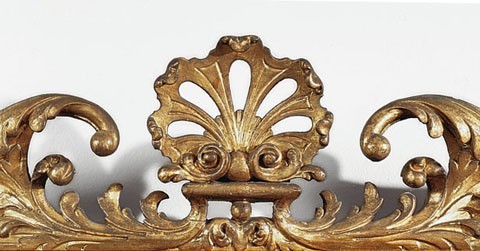
Detail of the applied shell and upper rail of a picture frame carved by John Welch for John Singleton Copley’s portrait of Isaac Smith, Boston, 1769. White pine, gilded. 58 1/2" x 48 1/4". (Courtesy, Yale University Art Gallery, gift of Maitland Fuller Griggs.)

Side chair, Boston, 1740–1750. Walnut and walnut veneer with maple and white pine. H. 38 5/8", W. 21 1/2", D. 21 1/4". (Courtesy, Diplomatic Reception Rooms, United States Department of State; photo, W.H. Brown)
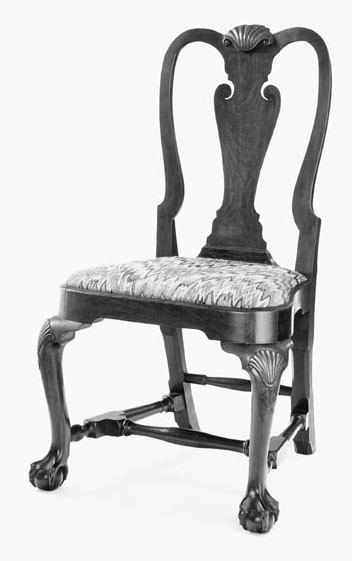
Side chair, Boston, 1740–1755. Mahogany; maple slip seat. H. 38 1/2", W. 22", D. 21 1/4". (Chipstone Foundation; photo, Gavin Ashworth.)

Settee, Boston, 1740–1755. Walnut with maple, birch, cherry, and walnut. H. 38", W. 65 5/8", D. 28". (Courtesy, Diplomatic Reception Rooms, United States Department of State.)
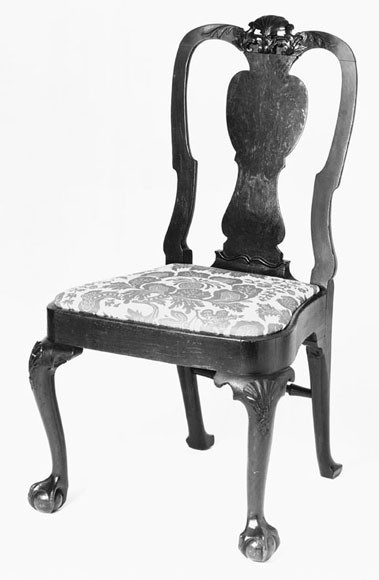
Side chair, Boston, 1735–1745. Walnut and walnut veneer with maple. H. 39", W. 20", D. 17 1/2". (Courtesy, Winterthur Museum.)
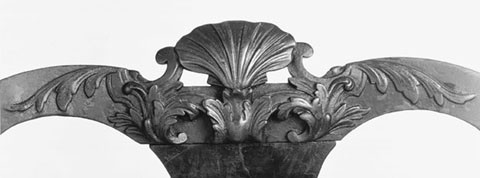
Detail of the crest rail carving on the side chair illustrated in fig. 36.
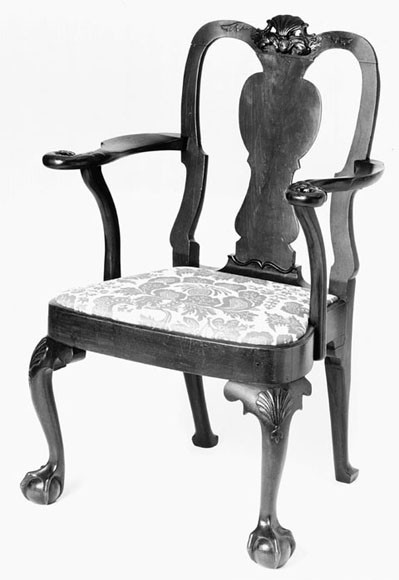
Armchair, New York, 1740–1755. Walnut; red gum slip seat. H. 39 1/2", W. 23", D. 19 5/8". (Courtesy, Winterthur Museum.)
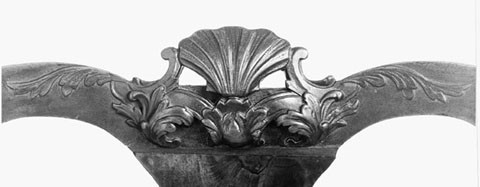
Detail of the crest rail carving on the armchair illustrated in fig. 38.

Side chair, New York, 1745–1760. Mahogany; oak slip seat. H. 38 3/4". (Collection of the Albany Institute of History and Art, gift of J. Townsend Lansing.)

Side chair, New York, 1745–1760. Mahogany; ash slip seat. H. 38 3/4", W. 21 1/2", D. 17 1/2". (Courtesy, Bernard & S. Dean Levy, Inc., NYC.)

Side chair, New York, 1745–1760. Mahogany; red oak slip seat. H. 39", W. 20", D. 17 1/2". (Courtesy, Winterthur Museum.)
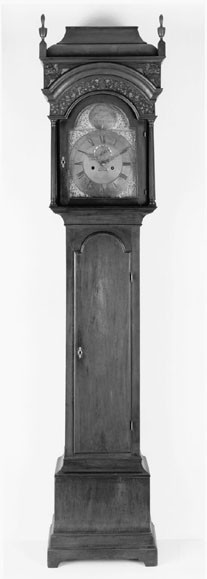
Tall clock case, Boston, 1740–1755. Movement by Thomas Claggett, Newport, 1740–1755. Materials and dimensions not recorded. (Private collection; photo, Gavin Ashworth.)
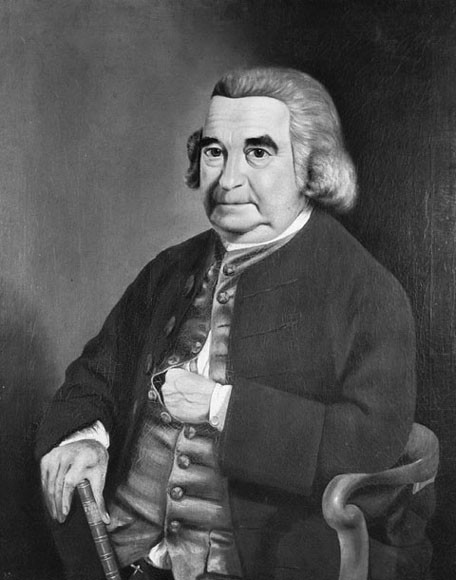
Abraham Redwood, attributed to Samuel King (1749–1819), Newport, ca. 1780. Oil on canvas. 42 1/2" x 33 1/2". (Courtesy, Redwood Library and Athenaeum, Newport, Rhode Island.) www.redwoodlibrary.org

Side chair, Boston, 1740–1755. Walnut. H. 38 3/4", W. 20 1/2". (Private collection; illustrated in The John Brown House Loan Exhibition of Rhode Island Furniture, 1965, pl. 8.)

Side chair, Newport, 1755–1775. Mahogany. H. 38 1/2", W. 20 1/2", D. 17 1/8". (Courtesy, Rhode Island Historical Society.)

Side chair attributed to John Goddard, Newport, 1760–1785. Mahogany and maple,. H. 39 5/8", W. 19 7/8", D. 16 1/4". (Courtesy, The Metropolitan Museum of Art; Rogers Fund, 1955.) (55.134). All rights reserved, The Metropolitan Museum of Art.
During the first half of the eighteenth century, Boston functioned as “the Metrapolis of New England.”[1] Within the vast market economy that linked Boston merchants to London and to the manufactures of England, intercoastal trade offered an ideal venue for those eager to capitalize upon innovation and material growth on the domestic front. Mercantile entrepreneurship charged both the city’s economy and its social structure as many sought to capitalize on the town’s allure in other colonial centers. Boston was the principal port of entry for British goods in the colonies, and fashions from the homeland found a receptive audience in its Anglocentric merchant class. In attempting to satisfy their own social and cultural aspirations, Boston’s elite set new standards for Anglo-aestheticism and material culture at other colonial ports.
The relationship between fashion and commerce is most apparent in Boston seating furniture from the second quarter of the eighteenth century. For decades, scholars have incorrectly attributed Boston Georgian chairs to New York or Newport, two cities with strong social and commercial ties to Boston and two of the most important destinations for Boston venture cargo. Confusion arose from the flawed assumption that an object’s provenance established its place of manufacture and that family and recovery histories were a viable touchstone for defining regional characteristics. Although provenance is an important consideration for furniture historians, it is often an indicator of retail history rather than origin.[2]
Style as a Commodity
Historians John J. McCusker and Russell R. Menard have concluded that the quality and character of each region’s exports “shaped the process of colonial development.” New Englanders were at a disadvantage because their natural resources—products such as wheat, cattle, and fish—were of little demand in Britain. Lacking a staple crop or rare commodity of the kind that flourished in the plantation colonies (tobacco, rice, indigo), Boston merchants turned to manufactures to help correct the balance of trade. Boston-made furniture—and in particular, seating furniture—was one such commodity. The export of such goods to other colonies challenged Britain’s role as the primary supplier of manufactured goods in British America. In a 1732 letter to Parliament, Lieutenant Governor William Gooch of Virginia complained that:
the People of New England are obliged to apply themselves to manufactures more than other of the Plantations, who have the benefit of a better soil and warmer climate, there has been of late much Improvements made there in all sorts of mechanick arts. . . . Escritors, chairs and other wooden manufactures. . . are now carried from thence to the ot[he]r Plantations, and if not prevented will do great Damage to the Trade & Manufactures of our Mother Country.[3]
English parliamentarian Edmund Burke described Boston as the “first city of New England, and of all North America” and noted that “New England[ers] . . . are in a manner the carriers for all the colonies of North America and the West Indies, and even for some parts of Europe.” He estimated that between December 1747 and December 1748, 340 vessels entered the port and 540 left for “foreign trade.” In addition to transporting local manufactures, Boston vessels carried staples and other products from the middle Atlantic and southern colonies to the West Indies, Britain, and Europe. In all, Boston ships accounted for nearly 40 percent of the carrying capacity in the colonies. Boston’s maritime dominance ensured that during the first half of the eighteenth century much of New York’s transatlantic trade went through Boston.[4]
Boston’s commercial success was rooted in the city’s shipbuilding industry. In 1693, Sir Josiah Child (1630–1699), president of the British East India Company, wrote that “New England is the most prejudicial plantation to this Kingdom. . . . his Majesty has none so apt for the building of shipping.” As early as 1660, Boston shipbuilders exported large ships to England, and in the early eighteenth century, Boston’s shipyards boomed as Britain ordered ships during Queen Anne’s War. By the end of the colonial period, nearly one-third of all British-owned ships were made in Boston. In addition, by the second quarter of the eighteenth century, approximately one-third of the city’s adult male population held shares in or part ownership of a seafaring vessel. In 1749, Dr. William Douglass (1691–1752) observed that shipbuilding was “one of the greatest Articles of our Trade and Manufacture,” employing and maintaining “above 30 Denominations of Tradesmen and Artificers.” Many of these craftsmen were also involved in the furniture-making trades.[5]
By comparison, shipbuilding did not play as pivotal a role in the economic structure of colonial New York and Rhode Island. In 1736, George Clarke, president of the Council of New York, informed the General Assembly that the neighboring provinces were reaping handsome profits from shipbuilding, but that the trade was “neglected and little used in this Province: and yet Nature has been as bountiful to us as to them, in giving us many materials for that use.” Historian Carl Bridenbaugh concluded that shipping, mercantilism, and stylistic evolution were so interdependent that New York’s “failure to develop shipbuilding on a large scale” explained “in large measure the backwardness of [its] . . . arts and crafts.” Rhode Islanders recognized the success of their Massachusetts neighbors, but they also lagged behind in shipbuilding and shipping. In 1721, the colony had only sixty bottoms with a 3,500 ton total burden. Twenty years later, Governor Richard Ward reported to the Board of Trade: “We have now one hundred and twenty sail of vessels belonging to the inhabitants of this colony, all constantly employed in trade.”[6]
Fueled by the port’s expanding economy, Boston’s population and artisan community grew during the second quarter of the eighteenth century. Between 1730 and 1743, the number of inhabitants rose from 13,000 to 16,382. By comparison, New York’s population grew from 8,622 to 11,000, Philadelphia’s increased from 11,500 to 13,000, and Newport’s rose from 4,640 to 6,200. At least 143 furniture-making tradesmen—sixty-two joiners, twenty-six cabinetmakers, twenty-two chairmakers, fourteen upholsterers, six carvers, five turners, six japanners, one glazier, and one chair caner—worked in Boston between 1730 and 1750. This number far exceeded that of any other colonial city. During the same time frame, New York had approximately thirty-five furniture-making tradesmen, including ten cabinetmakers, one chairmaker, four upholsterers, one carver, seventeen turners, and two japanners. Several of these turners may have been chairmakers, but most turners did not have the training to manufacture joined cabriole leg forms. Similarly, no chairmakers were recorded in Newport between 1730 and 1750.[7]
A thriving urban setting was essential for specialized tradesmen such as Samuel Grant (1705–1784), a Boston upholsterer who established himself in 1728 “at the Crown and Cushion in Union Street near the Town Dock.” Grant’s ledgers, which intermittently span the years 1728 to 1771, document the extensive activities of his shop and reveal that he was both a successful upholsterer and a merchant. Within the hierarchy of furniture-making tradesmen, the upholsterer’s profession ranked among the most prestigious and the most lucrative. In The London Tradesman (1747), Robert Campbell wrote that an upholsterer must have “not only judgment of material but taste in Fashions . . . skill in workmanship . . . and set up as a connoisseur in every article in the house.” Many upholsterers came from well-to-do families, an important background for craftsmen who needed to establish credit at the start of their careers to purchase expensive upholstery fabrics. Ultimately, some of these tradesmen capitalized upon their professional connections and became merchants.[8]
By its very nature, the upholstery business was closely tied to several other trades, the most obvious being chairmaking. Grant, for example, purchased frames from local chairmakers Thomas Dillaway, James Johnson, Samuel Ridgway, Clement Vincent, Henry Perkins, and Edmund Perkins, Sr., as well as unspecified work from joiners Daniel Ballard, John Leech (Leach), and William Pain (Payne) and from carvers Benjamin Luckie and John Welch. Artisans of Grant’s stature often patronized several craftsmen to maintain a stock-in-trade for both the local market and for export.[9]
Grant also relied upon local merchants such as Charles Apthorp to act as middlemen. As former paymaster and commissary of the British forces in the colonies, Apthorp had the resources and connections to import English textiles in bulk. Among Grant’s larger purchases from Apthorp were ribbon for £1767.14.7 in December 1740 and “Sundry Tabbys” for £1725.19.1 in May 1749. In lieu of cash, Apthorp often accepted upholstered furniture and services such as “work at house” or “Makeing Curtains for 4 Window headed.” On October 25, 1736, Grant credited Apthorp’s account with “2. doz: chairs” valued at £36, “2. Elbow ditto” valued at £10.16, a “Couch Frame & Squab” valued at £7.7.9, and “canvas & packing” valued at £1.5. The inclusion of packing in the order suggests that these items were being prepared for shipment out of Boston. Subsequent credits to Apthorp’s account were even larger. On May 13, 1741, he received “54 Leather Chairs” and “5 Elbow ditto” valued at £104, and on May 18, 1748, he received “6 Walnut compass chairs & packing” valued at £61.10. Between March of 1738 and 1748, Apthorp received at least three hundred chairs from Grant. Many of these transfers included charges for packing materials or directives to specific ships and ship captains, indicating that the chairs had been prepared for export.[10]
Several of these shipments can be tracked through clearance records for the port of Boston. For example, on April 17, 1744, Grant noted: “Charles Apthorp’s Sent on Board Capt. Trecock 6 doz Leather Chairs” valued at £117.6. Just four days later, the Snow Friendship, captained by “M. Trecothick” and owned by “C. Apthorp,” cleared Boston for Philadelphia with “8 doz. and 2 Leather Chairs” in its hold. At least seventy-two of those chairs were from Grant’s shop.[11]
Grant had similar commercial arrangements with several other Boston merchants. On March 6, 1743/44, he charged Boston merchant Jonathan Jones £30.18 for “12 Maple Chairs @ 50/ 4 yds oxamb. & packing,” and designated them for shipment “on Board his Vessell Capt. Power.” The following month, the sloop Hopewell, captained by “Joseph Powers” and owned by “John Jones,” left Boston for “Providence” with a cargo that included “1 doz. chairs.”[12]
Grant also owned shares in several ships, which gave him access to the markets of his co-investors and was cheaper and less financially risky than maintaining his own vessels. Between 1744 and 1748, Grant held shares in the sloop Willing Mind and the schooner Betty. These vessels made at least eight trips to Philadelphia, four to Virginia, and several to ports in Maryland, Newfoundland, and the West Indies. Cargoes on these voyages included at least three tables, four desks, and over two hundred chairs.[13]
Boston’s tremendous venture cargo industry adversely affected some furniture craftsmen in other ports. In 1742, Philadelphia upholsterer Plunkett Fleeson advertised “Several Sorts of good Chair-frames . . . finished cheaper than any . . . imported from Boston, and in Case of any defects, the Byer shall have them made good; an Advantage not to be had in the buying [of] Boston Chairs, besides the Damage they receive by the Sea.” Two years later he rebuked “the Master Chair Makers in this City . . . [for] Encouraging the Importation of Boston Chairs.”[14]
The appeal of Boston manufactures in other colonies was grounded in the city’s own brand of mediated consumerism. During the first quarter of the eighteenth century, Boston merchant-upholsterers established themselves as arbiters of taste in other colonial ports. The material goods that they imported and manufactured were a source of entertainment—“the spark of a new kind of social discourse.” In 1735, John Oldmixon (1673–1742) wrote:
The conversation in Boston is as polite as most of the Cities and Towns of England; many of their merchants having traded into Europe and those that stayed at home having the advantage of society with travelers. . . . a gentleman from London would almost think himself at home in Boston when he observes . . . their houses, their furniture, their tables, their dress and conversation, which, perhaps, is as splendid and showy as that of the most considerable tradesman in London.[15]
Anglicization was the catalyst that enabled Boston tradesmen and their merchant patrons to capitalize on the city’s status as the principal source for British goods in the colonies. Many prominent Boston merchants, such as Charles Apthorp, Henry Bromfield, Peter Faneuil, John Fayerweather, and Thomas Hancock, were members of the Church of England and became Loyalists during the Revolution. They wore English-made garments, had themselves immortalized in the manner of minor British royalty by artists such as Robert Feke and John Singleton Copley, and furnished their homes with English imports or locally made interpretations of them. Style became a commodity of personal and public effect. As a result, “Boston-made” became synonymous with “the latest [English] taste,” and “Boston chairs” became synonymous with “London chairs.”
The Pink of the Mode in Boston Georgian Seating
A set of eight side chairs (fig. 1) that descended from Charles (1698–1758) and Grizzell (Eastwick) (1709–1796) Apthorp was the genesis for many of the stylistic and structural details that became hallmarks of Boston seating furniture during the 1740s and 1750s; however, misinterpretations of the chairs’ history, style, and structure resulted in their being attributed to New York. Indeed, the assumption of their New York origin has been so long-standing that the Apthorp chairs became a touchstone for attributing a large group of related Boston seating to that city. The theory that they were purchased in New York by Charles’s son, Charles Ward Apthorp (1729–1797), during the 1750s or 1760s and subsequently returned to the Boston branch of the family is refuted by strong historical and physical evidence. Family tradition maintained that the chairs belonged to Charles and Grizzell and that they descended in the female line from their daughter, Susan Apthorp Bulfinch (1734–1815), to Elizabeth Bulfinch Coolidge (1777–1837), to Elizabeth McCalla Miller (b. 1875), and to Elizabeth Symington before being purchased by the New York antiques firm of Ginsburg and Levy.[16]
Charles Apthorp served as the American agent for Thomlinson and Trecothick, the London merchant house that supplied money for the British army in America. His daughter Grizzell married Barlow Trecothick, and his son John moved to London to become a member of the firm. Other Apthorp progeny were conveniently placed in businesses in New York City and Kingston, Jamaica.[17]
Through his connections with London suppliers and his association with Anglophiles such as Thomas Hancock, Apthorp kept abreast of the latest British fashions. In addition to the set of chairs, his household furnishings included a “Mohogony Cabinet with glass doors” valued at £30 and a “Mohogony Beauro with Glass doors” valued at £32. The latter may have referred to the bombé bureau with cabinet illustrated in figure 2. Several scholars have speculated that this piece may have introduced the bombé form to Boston. Similarly, London side chairs (fig. 3) undoubtedly served as the model for the basic design of the Apthorp suite.[18]
Like many London chairs from the late 1720s and early 1730s, Apthorp’s have inverted baluster splats with walnut veneer, angular S-shaped stiles, compass seats, shell-carved crests and knees, and tapered rear legs with small squared feet (fig. 1). His estate inventory, taken in 1759, indicates that his “Best Parlour” had “a sett of Yellow damask Window Curtains & Cushions” and “10 Mehogony Chairs Yellow Bottoms” valued at £16. The latter description is significant because several chairs from the Apthorp set retain fragments of their original, yellow silk damask upholstery. Although the chairs are made of walnut, their brilliantly figured veneers could have been mistaken for mahogany by his estate appraisers. [19]
The carved details on the chairs provide conclusive evidence that they were made in Boston. The carving is attributed to John Welch (1711–1789), the most prolific carver (fl. 1732–1780) in pre-Revolutionary Boston. Among Welch’s many commissions were at least twenty-five ornately carved picture frames, many of which were ordered by artist John Singleton Copley (1738–1815) (fig. 4). Several of these frames, including the one on Copley’s portrait of Jeremiah Lee, have distinctive, V-shaped shells with scrolls and acanthus leaves that are executed in the same manner as the corresponding elements on the crests of the chairs (figs. 5, 6). The omission of the imbrication (scale motifs) on the frame scrolls may have been to simplify the surface for gilding. In colonial American furniture, this combination of details is unique to Welch. Similar acanthus clusters also occur on a Boston desk-and-bookcase with a scrollboard appliqué attributed to Welch (figs. 7, 8).[20] The appliqué leaves are accented with cabochons rising from the spines—a detail that occurs on several chairs and case pieces with carving attributed to his shop (see figs. 27, 28, 36, 37).
The embryonic feet of the Apthorp chairs are similar to London claw-and-ball feet of the early 1730s (fig. 9). Rather than placing the ball of the foot at the center of the walnut blank (fig. 10a), Welch positioned it at the forward corner (fig. 10b). This change signals an evolution away from frontally oriented legs (fig. 10c) such as those on compass seat chairs in the late baroque (or “Queen Anne”) style. Such chairs probably came into fashion in Boston during the mid to late 1720s. On October 14, 1729, Samuel Grant sold New York ship captain Arnout Schermerhorn a “red Chainey” chair with a “New fashion round seat.” Although this chair almost certainly had cabriole legs, the first reference to them occurred the following year when Grant billed Nathaniel Green £2.12 for “1 Couch frame horsebone feet.” Later entries for chairs with “horsebone feet” document a progression of cabriole leg/foot forms from sawn and beaded to turned. The Apthorp chairs have the earliest form of claw-and-ball feet and probably date from the early 1730s. On March 8, 1732/33, Grant sold “4 doz: Leathr chairs claw feet” to Peter Faneuil for 27 shillings each.[21]
Boston cabinetmakers and carvers also began using claw-and-ball feet on card tables and tea tables during the 1730s. A card table that descended in the Dalton family of Boston (fig. 11) has feet that are virtually identical to those of the Apthorp chairs (figs. 9, 12). The Dalton table and the concertina-action table illustrated in figure 13 also have escape cuts (saw kerfs made during the removal of the waste stock) on the inner curves of the ankles, like several chairs from the Apthorp set. These cuts reinforce the notion that Welch was initially unfamiliar with the construction of cabriole legs with claw-and-ball feet. On later examples, he and his contemporaries positioned the toes near the side corners of the stock to fully utilize the dimensions of the material (see figs. 10a, 16).[22]
Grant’s ledgers document his association with Apthorp and Welch. On May 20, 1738, Grant recorded that Apthorp paid “his order to Jno. Welch 20—”, although he did not specify the nature of the transaction. A year later, Grant noted, “Chas. Apthorp pd ordr to Jno Welch end:d to Gooch 100.” Similarly, entries in Grant’s account book record several transactions between Welch and merchants such as Thomas and James Perkins. On June 8, 1736, and December 2, 1741, Thomas paid Welch £40 and £60 respectively, and on May 24, 1744, he and James paid Welch £30. Presumably, these payments were for furniture carving, for, like Apthorp, these merchants determined the amount of carved work applied to their purchases.[23]
The materials and construction of the Apthorp chairs (fig. 1) also relate more closely to cabinet- and chairmaking practices in Boston than to those in New York. The splats of the Apthorp chairs are crotch walnut veneered on maple—a sturdy, stable hardwood commonly found in New England furniture. The walnut appears to be from the same flitch used on a slightly later set of chairs that reportedly descended in a Boston family. The cost of the material and the amount of labor involved in producing splats of this quality was substantial, but the visual effect of their matching veneers was stunning.[24]
By the second quarter of the eighteenth century, Boston had a thoroughly established tradition of veneering based upon English precedent. Wealthy merchants such as Peter Faneuil purchased veneered furniture made locally and from their agents abroad. In 1738, Thomas Hancock instructed his London factor to “Send with my Spring Goods a Handsome Chiming Clock . . . with a Good black Walnutt Tree Case veneer’d work, with Dark lively branches . . . [and] three handsome Car’d figures Gilt with burnish’d Gold.” By contrast, veneered furniture made in New York and Newport during the first half of the eighteenth century is extremely rare.[25]
Like many eighteenth-century Boston chairs, Apthorp’s have maple slip seats and triangular white pine glue blocks (blocks may be later additions). The chairs also had yellow silk damask covers that were nailed to the edges of the slip seats (fig. 14)—a distinctive technique that probably evolved from leather chair upholstery. In 1747, Grant sold Jonathan Prescott six walnut compass seat chairs “cov’d over close & nailed.”[26] This description could refer to either edge-nailed slip seats or, more likely, over-the-rail upholstery. New York chairmakers were far less regimented in the construction of slip seats and were more likely to use oak, cherry, tulip, or gum than maple. The formulaic approach of Boston’s chairmakers may have been in response to the high volume demands of the export trade.
Material and documentary evidence indicates that many of the details incorporated in the Apthorp chairs remained fashionable in Boston until the mid-eighteenth century. Were it not for its knee carving, the easy chair illustrated in figure 15 could almost be en suite with the Apthorp chairs. The shells on the easy chair are longer, and they have rounded lower edges and husks (or bellflowers). This design is less naturalistic than the knee carving on the Apthorp chairs, but it is better suited to the shape of cabriole legs
.
Grant’s accounts refer to numerous chairs with features similar to Apthorp’s. He charged Benjamin Dolbeare £6 for “2 Chairs false Seats Flat Strechers” on February 3, 1741, and £10 for “2 Compass ditto” the following day. Later entries record sales and exchanges of chairs with carved crests, legs, and feet. For example, on May 23, 1745, he charged Thomas and James Deskins £13.10 for “9 Wallnutt Chairs Carv’d Tops & Leggs.” [27]
Although the Apthorp chairs have an early experimental quality, several related examples show subtle refinements and modifications. A set of six chairs that descended in the Fayerweather and Bromfield families of Boston are representative (fig. 16). Some of the slip seats are marked “Capn Fayerweather” for merchant John Fayerweather (1685–1760), who, like Apthorp, bought large quantities of chairs and other goods from Samuel Grant. Fayerweather may have given the chairs to his daughter, Margaret (1732–1761), and son-in-law, Henry Bromfield (1727–1820), near the time of their marriage in 1749. Family tradition maintains that Margaret embroidered the covers for the seats.[28]
The carving on the crests (fig. 19) is attributed to Welch, but the design is simpler and required far less labor than that on the Apthorp suite. The small leaves that rise from the scroll volutes are hastily carved versions of those on several of Welch’s simpler frames. Although the knee carving on the Fayerweather chairs is too generic to support an attribution, similar shell and husk designs occur on other chairs in the group (see fig. 21) and on contemporary London chairs (fig. 3). With their simple convex lobes, these shells required less tools and less time than the more naturalistic ones on the knees of the Apthorp chairs and the easy chair (figs. 17, 18).
The carving on the Fayerweather chairs is also related to that on a desk-and-bookcase that belonged to Boston goldsmith John Allen (1671–1760) (fig. 20), on a very similar set of Boston side chairs that reportedly descended in the Baldwin family of New York (fig. 21), and on the high chest illustrated in figure 22. The acanthus leaves on the crests of both sets of chairs are similar to those at the bottom of the scrollboard appliqué on the Allen desk (figs. 19, 23, 24), and the vine carving on the chairs has flowers, berries, and leaves that nearly quote those on the original (lower) shell drawer of the high chest (figs. 19, 24, 25). The husks and leaves on the crests and shell drawer also match those on the feet of the Allen desk (fig. 26). The feet of the chairs and high chest are, again, very similar. Both sets are derived from the feet on the Apthorp chairs, but their toes were set at the corners of the stock (see fig. 10a). [29]
The Fayerweather and Bromfield families patronized Welch both directly and indirectly. An elaborate coat of arms (at the Society for the Preservation of New England Antiquities) that descended in the family of Margaret Fayerweather’s brother, Thomas (1724–1806), has acanthus leaves that are virtually identical to corresponding elements on Welch’s picture frames. Welch’s shop also furnished carving for an extraordinary tall clock case commissioned by Henry Bromfield (figs. 27, 28) and for several related Boston case pieces made between 1735 and 1755.[30]
The Fayerweather chairs are important for their Boston history and their more standardized expressions of the “new fashion” style mentioned by Grant and exemplified by the Apthorp suite; however, several other chairs figure more prominently in the development of venture cargo models. The side chair illustrated in figure 29 is one of the earliest examples with Boston-style block-end stretchers, single-crook styles, and a conforming veneered splat. Except for the veneer, variations of all of these details (or combinations of them) occur on later venture cargo chairs (see fig. 34). The modified trifid feet were less expensive alternatives to claw-and-ball feet, but they, too, were based on early Georgian prototypes. Although somewhat more superficial, the carving on the crest and knees is derived from the Fayerweather and Apthorp chairs, respectively. Like many eighteenth-century carvers, Welch could adjust his work to accommodate his patron’s pocketbook. This flexibility is most discernible in his frames and his carving for case furniture.[31]
A slightly later Boston side chair features many of the same details, while exhibiting a rear leg form common on Boston late baroque pad foot chairs (fig. 30). The distinctive carved shell on the crest rail is virtually identical to the one Welch carved for John Singleton Copley’s portrait of Isaac Smith (figs. 31, 32). Similar shells occur on other Copley frames and on case pieces of obvious Boston-area origin.[32]
Not all of the chairs in this genre exhibit carving attributable to Welch. A side chair (from a set of at least four) that reportedly belonged to New York merchant and ship captain John Aspinwall (1705/6–1774) (fig. 33) is probably from the same chairmaking shop that produced the Apthorp, Fayerweather, and Baldwin suites. All have elaborate walnut veneers and similar splats, stiles, and knee blocks; nevertheless, the shells on the crest rail and knees of the Aspinwall chair resemble those on many venture cargo chairs. These simpler shell forms probably represent the work of several different hands. Aspinwall was a business associate of at least two other New York merchants who purchased Boston furniture—Gerard Beekman and Henry Lloyd. Aspinwall probably acquired his chair during one of his frequent voyages to Boston. For example, between March 25, 1739, and September 29, 1740, he made at least five round trips between New York and Boston.[33]
Making Chairs for Export
The carving and veneers on the preceding chairs distinguish them from the basic export model of the 1740s and 1750s. Made of walnut (and in a few instances mahogany), the latter featured a compass seat, single-crook stiles, a conforming, baluster-shaped splat, and claw-and-ball feet (fig. 34). A few structural and ornamental options—stretchers, alternative crest and splat shapes, and simple carved shells—were available, but it is unlikely that many venture cargo chairs had veneered splats or intricately carved crests like the Apthorp and Fayerweather examples. Moreover, several tradesmen less accomplished than Welch clearly carved the shells and feet of many export-quality chairs and some of the simpler elements on commissioned work. Venture cargo chairs had to be constructed efficiently and priced accordingly, which eliminated costly carving and veneering. Grant’s payments to chairmaker Edmund Perkins suggest tremendous production: £695.5.2 for unspecified work on January 11, 1742; £694.12.7 for “chair frames etc.” on February 1, 1745/46; and £790.18.6 for “Chair Frames etc” on February 13, 1746.[34]
As part of this manufacturing process, upholsterers such as Grant frequently supplied raw materials for the craftsmen in their networks. On August 20, 1743, he debited Perkins’s account £16.2.7 for 2,304 feet of boards. The following month, Grant recorded the payment of £151.7.6 for “Voyages to Virginia . . . for . . . Walnutt &c.” and debited Perkins’s account £19.5 for “75 1/2 feet Wallnutt logs.”[35] Later entries record similar transactions. Because black walnut grew slowly in the forests of eastern Massachusetts, Boston merchants imported it from the southern colonies. Virginia walnut was especially prized for its grain and figure.
Chairmaker John Perkins’s (1723–1776) inventory, taken after Boston’s Great Fire of 1760, showed the volume of his shop’s manufacture, for it listed “220 wallnot Feet for Chairs” and “500 foot wallnt 2 Inch Plank.” Similarly chairmaker, Joseph Putnam (fl. 1750–1767) lost “350 wallnot Feet for Chairs.”[36] The mass replication of parts, such as “feet” (chair legs), stretcher components, and loose seats, was essential to increase production and to minimize the cost of manufacturing chairs for export; however, standardization and the economics of venture cargo took a toll upon creativity and limited stylistic developments.
Tracing Fashion’s Cargoes: New York
During the late seventeenth and early eighteenth centuries, New York was one of the most important markets for Boston merchants who traded in imported and locally manufactured goods. Several trading firms, such as those of the Faneuils, Wendells, and Deblois, established branches in New York during the early eighteenth century. Leather chairs were one of the most important commodities exported from Boston to New York during this period. On October 22, 1701, New York merchant Benjamin Faneuil (b. La Rochelle, France 1658, d. New York 1719) imported “12 leather chaires. . . [from] Boston where the above goods were made,” and over the next several years he could hardly keep up with the demand. Faneuil acted as a middleman for Boston merchant-upholsterer Thomas Fitch (1668/9–1736). Fitch was an artful promoter of Boston-made products who understood that perceptions of stylishness and desirability could be manipulated for profit. On March 28, 1709, Fitch sold “Abram” Wendell of Albany “Twelve Russhia Chairs & one Arm [chair].” Wendell evidently balked at the price, causing Fitch to cajole: “the chairs are extraordinary Leather & at the lowest price: I refused ready money for them at the same price meerly to sute ye.”[37]
The ledgers and letterbooks of Fitch and the account books of his apprentice, Samuel Grant (worked independently, ca. 1728), document the evolution of style and trade patterns in Boston’s chairmaking industry during the first half of the eighteenth century. Fitch traded primarily in baroque leather chairs (turned examples, with or without carving, and transitional crook-back chairs), and the vast majority of his patrons were merchants, lawyers, and physicians in Boston, New York, and Newport. Grant maintained and expanded many of the trade channels developed by his master, but his seating forms were in the late baroque and early Georgian styles.[38]
The “red Chainey” chair with a “New fashion round seat” that Grant sold Arnout Schermerhorn, shortly after completing his apprenticeship, signals a departure from the baroque examples marketed by his master; nevertheless, it documents the persistence of earlier trade patterns. Schermerhorn (1686–1749) was a New York shipmaster whose family established a packet service between New York, Boston, and Charleston, South Carolina. On October 4, 1729, the New-England Weekly Journal reported that his ship arrived “from New-York.” Schermerhorn purchased the chair on that date and probably carried it to New York when his ship departed two weeks later.[39]
Capitalizing on the continued popularity of Boston seating furniture, merchants such as Grant, Peter Faneuil, and Henry Bromfield shipped both commissioned chairs and venture cargo to New York during the 1730s and 1740s. Among the many documented examples are Grant’s sale to “Mary Brown of New Y[ork] 1 Easy Chair . . . 20.14.11” on August 9, 1736; Peter Faneuil’s shipment of an easy chair “ordered for a lady” to New York in 1737; Joshua Winslow’s shipment of “6 Wallnutt Chairs Covered with Crimson Harrateen 40.10.2” to New York on November 28, 1746; and Henry Bromfield’s sale of “12 Black Walnut Chair Frames” and “12 Leather Bottoms for Ditto” to Isaac Lattouch of New York on January 8, 1747/48.[40]
Between 1744 and 1748, ships transporting furniture made at least fifty-four trips from Boston to New York. Their cargo included at least twenty-nine desks, four “Great Chairs,” twenty-three tables, eight “Chest of Draws,” nine couches, three easy chairs, one bookcase, two clock cases, one “scrutoire,” one cradle, nine boxes of “Household Furniture,” and 1,004 chairs. By contrast, no chairs appear in the cargo manifests of Boston-bound ships recorded in the New York Shipping Returns for 1731–1738 and 1735–1752 and in the New York Treasurer’s Accounts for 1739–1754. These findings are consistent with one New Yorker’s comment in 1734 that “our luxury consists . . . [more] of what is imported than what is of [our] own growth manufactories.”[41]
The acquisition of luxury was clearly on the mind of New York merchant Henry Lloyd when he arranged for the purchase and delivery of a Boston-made carriage to his home on Long Island. On September 24, 1748, his eldest son (living in Boston) wrote, “[the] chair you’l receive . . . its the very pink of the mode and as good a one as can be procurd.” The following year, Henry II sent his father “12 Chair Fraims . . . £72,” “1 Ditto round about. . . £9,” and “13 seats stuffing & Covering . . . £31.4.” Although Massachusetts currency was inflated during the late 1740s, the cost of the chairs was still relatively high.[42]
Many wealthy New York merchants such as Henry Lloyd looked to London and Boston for the latest fashions. As William Smith observed in his History of the Province of New-York From the First Discovery to the Year 1732 (1757):
In the city of New-York, through our intercourse with the Europeans, we follow the London fashions; though by the time we adopt them, they become disused in England. Our affluence . . . introduced a degree of luxury in tables, dress, and furniture, with which we were before unacquainted. But we are still not so gay a people, as our neighbors in Boston.
Business associations, friendships, and family connections strengthened ties between the mercantile communities of Boston and New York. For example, Charles Apthorp was the godson of Henry Lloyd and the business associate and friend of Lloyd and his son, Henry II. Following Apthorp’s sudden death on December 1, 1758, Henry II wrote his father, “in Mr. Apthorp I have lost my best friend in this place. . . . I could . . . always be sure of his best advice & secrecy. . . . when I had occasion for a sum of money . . . [he] would Cheerfully lend any sum I wanted.”[43]
The Lloyds also did business with William Beekman (1684–1770), a New York merchant who purchased leather chairs from Fitch and owned the Boston settee illustrated in figure 35. New York shipping records document Beekman’s extensive trade with Boston. Between May 8, 1735, and October 24, 1737, his ship William and Mary logged separate departures for Boston (twice), “Boston: N. England,” “N. England,” “Rhoad Island,” and “N. London and R. Island.” During the same time frame, this ship returned twice from Boston, twice from Rhode Island, and once from “Boston and Perth Amboy.” On May 29, 1736, the William and Mary carried “10 Desks” from Boston to New York—a clear indication that Boston goods serviced Beekman’s mercantile strategy. By contrast, furniture was never included in the William and Mary’s outbound New York cargo.[44]
The overall design of Beekman’s settee (fig. 35) is based on London examples like the one shown in Sir Joshua Reynolds’s portrait of Warren Hastings (in the National Portrait Gallery, London), but its secondary woods—maple, white pine, birch—are typical of Boston upholstered furniture.[45] The leg profile, shell carving, and basic form of the claw and ball is derived from the Fayerweather chairs. The feet of the settee are the standardized type, with deep webbing and hollows (between the claws) that stop abruptly at the ankle. Similar legs and feet appear on a variety of Boston furniture forms, including desks, high chests, dressing tables, card tables (usually with turrets), tea tables, and pier tables.
A set of side chairs that descended in the Van Cortlandt family provides further evidence of New Yorkers commissioning elaborate Boston seating forms (fig. 36). These objects also reveal that Welch had refined many of the details he had introduced on the crests of the Apthorp chairs, without simplifying them as on the Fayerweather suite. The Apthorp chairs and Van Cortlandt chairs both have crests with high-relief strapwork and acanthus clusters (figs. 5, 37), but the leaves of the Van Cortlandt chairs are accented with curved cabochons like those on the spandrel appliqués of Henry Bromfield’s tall clock case (fig. 28) and the scrollboard appliqué of the desk-and-bookcase illustrated in figure 8. Welch also substituted low-relief acanthus leaves for the stiff branches on the crests of the Apthorp chairs and omitted the imbrication on the strapwork.
Another chapter in the history of this suite unfolds with two New York armchairs made to accompany the side chairs shortly after their arrival (fig. 38). The makers of the armchairs enlarged the splat and crest proportionally but copied the dimensions and design of the carving on the Boston prototypes (figs. 37, 39).[46] The New York carver was somewhat less skilled than Welch, whose divergent technical repertoire and tool kit produced a much clearer, more naturalistic design. Other variations occur in the carving of the feet. The Boston examples have deeper webbing and high-ridged toes.
Basic construction details also separate the side chairs and armchairs. The side chairs have several “standard” Boston features, including walnut-veneered splats, single-piece shoe/rear rail components, turned rear stretchers, and maple slip seats; whereas the armchairs have solid walnut splats, a separate shoe and rear rail, no rear stretchers, and red gum slip seats, all in keeping with New York chairmaking practices. The eagle head arm supports may also be an Anglo–New York conceit, since they evidently appear there earlier than in Boston. In addition, the sinuous, curved legs of the armchairs have direct parallels in later New York chairs, tables, and case furniture.[47]
New York Chairs in the Boston Style
To compete with imports and to supply the expanding local market, New York chairmakers adapted details from Boston chairs that were either ordered by New Yorkers (see figs. 21, 33) or arrived as venture cargo (see fig. 34). The side chair illustrated in figure 40 is clearly derived from a Boston venture cargo chair; however, the maker replaced the Boston square rear foot with its New York equivalent—a rounded slipper foot. The New York chair also has an oak slip seat and rounded, two-part oak glue blocks like many other locally made examples. The feet appear to be by the same artisan that carved the feet of the Van Cortlandt armchairs.
Another New York side chair (fig. 41) shares details with ornate Boston chairs (see especially figs. 16, 21) as well as with export-grade models (fig. 34). The chairmaker incorporated a standard Boston splat with double-crook stiles and carved details commonly associated with more expensive commissioned chairs. The exaggerated cabriole legs, undercut knees, and nearly webless claw-and-ball feet have no precedent in Boston Georgian seating, but nearly identical details occur on a set of chairs that descended in the Livingston family of New York and a small group of turret-top card tables and china tables with New York histories. Moreover, the shell and highly stylized acanthus carving on the crest rail is by the same hand that executed the knee carving on the aforementioned china tables.[48]
The side chair illustrated in figure 42 departs even further from Boston seating. Although the makers retained the double-serpentine, beaded shoe of the Boston prototype, they modified its double-crook stiles to harmonize with the thin waist and exaggerated volutes of their splat. This distinctive splat and stile shaping appears on several other New York chairs. Other New York details are the gum slip seat and pad rear feet. The knee design, which features broad leaves flanking a cross-hatched reserve, also occurs on numerous tables and chairs from that city.
Tracing Fashion’s Cargoes: Newport
During the first half of the eighteenth century, Newport did not have an extensive chairmaking industry. Wendell Garrett’s checklist of Newport craftsmen included no chairmakers active between 1730 and 1750, and Jeanne Vibert Sloane’s research uncovered only two references to Newport cabinetmakers selling chairs, both after 1760. Shipping records, probate inventories, and correspondence suggest that case forms and tables were the main products of Newport’s craftsmen. A survey of harbor records from six Virginia ports reveals that at least 728 chairs arrived on Boston vessels between 1727 and 1755. During the same period, Rhode Island ships regularly transported desks and tables to Virginia, but never chairs. It was not until December 4, 1755, that a Rhode Island cargo included seating forms. Moreover, material evidence strongly suggests that much of the seating used in Rhode Island before 1750 originated in Boston.[49]
Commercial ties between Boston and Newport were particularly strong. For example, at least forty-two of the vessels that entered New York harbor between March 25, 1738, and June 24, 1743, listed Boston and Rhode Island as their previous ports of call. Indeed, in July 1744, Annapolis physician Alexander Hamilton reported hearing “news of a coasting vessel . . . taken by a French privateer in her passage betwixt Boston and Rhode Island.”[50]
Because of Newport’s close proximity to Boston, land routes were also important in the conveyance of goods. In 1731, Rhode Island Governor Joseph Jencks wrote:
Directly from Great Britain we have but a Small Quantity of Goods having but two Vessels in a year Trading thither, But by the Way of Boston we receive almost all we use . . . Duck Cordage Broad Cloths Drugges Stuffs Serges Shaloons Hollands Garlix thread Laces Seyths Nailes & other Iron Ware Needles Pins tape . . . they being by our Merchants and Shopkeepers mostly imported by land.
By 1736, a regular stage line united the seventy-mile span between Boston and Newport. Bostonian Jonathan Foster initiated a weekly carrier service in 1745 but soon had a rival when Newporter Mathew Pate established a similar service.[51]
A fascinating series of letters between New York City merchant Gerard G. Beekman (1719–1797) (Dr. William Beekman’s nephew), Boston merchant Stephen Greenleaf, and Newport ship captain John Channing help personalize the Boston–Newport–New York trade axis. In an August 11, 1746, letter to Greenleaf, Beekman wrote: “I received . . . the Cheirs in good order . . . we Like them much and so does most that See them [emphasis added]. . . . If you’d be so good and pay Mr. Johnson for the Clock Case shall reimburse you on first advice.” (“Mr. Johnson” may have been Boston cabinetmaker William Johnston [fl. 1741–1756] or japanner and engraver Thomas Johnston [fl. 1732–1767].) The following month, Beekman requested that Channing “pay Mr. Clagget for my Clock Case which may Engage him to keep it till the Case Come which I think is Long.” (“Mr. Clagget” was probably William Claggett [1696–1749], a Boston clockmaker who moved to Newport about 1719.) Beekman’s frustration over the delay in receiving his clock case persisted. In a December 22, 1746, letter to Greenleaf he griped: “I think Mr. Johnson has make too much diffirence and the Charge of My Clock Case and those sent my Neighbour, having Charged me £10 more than he has them.” The New York merchant’s luck was no better when it came to the clock’s movement. In September 1747, he wrote Channing: “Pray Dont forget forwarding my Clock as soon as possible, I have the Case Which is of as much use as a bell without a Clapper.”[52]
A tall clock case with a movement by William Claggett’s son, Thomas (fl. Newport ca. 1730–1797), provides material evidence of the strong mercantile and trade connections between Boston and Newport (fig. 43). The case is attributed to the same Boston shop that produced Henry Bromfield’s clock case (fig. 27). Both have similar molding profiles and waist doors with integral moldings cut with the same scratch stock that produced the lower element of their arched cornices. Either Claggett or his patrons were importing Boston cases by the 1730s. The earliest Boston cases with his movements have elaborate burl walnut veneers, and one has a history of descent in the Bull family of Rhode Island.[53]
Samuel Grant’s accounts document the direct and indirect shipment of chairs to Rhode Island during the same time frame. For example, on February 1, 1744/45, Grant recorded a transaction with “Samuel Rhodes of Newport.” Other customers included “Sarah Leech of Newport” and “Colo. Charles Church of Bristoll.” Leech purchased sixteen looking glasses and some fabric valued at £166.5 on May 20, 1737, and Church purchased “8 Wallnutt Chairs Seats Covered with Leather @ 80/ . . . 32.0.0” in 1746. Grant also sold numerous chairs to ship captains who traveled between Boston, Newport, and New York.[54]
Newport merchant Abraham Redwood (1709–1788) purchased Boston chairs through his agent Stephen Greenleaf (also an agent for Gerard Beekman). On May 26, 1749, Greenleaf wrote, “I received yours via friend Proud and have ordered 8 chairs and two roundabouts . . . which will be strong and neat and not high priced.” Samuel King’s (1748/9–1819) portrait of Redwood depicts the sitter in a roundabout chair that may be one of the two mentioned in Greenleaf’s letter (fig. 44).[55]
Newport Chairs in the Boston Style
Most of the Boston chairs with Rhode Island histories are export grade, such as the set that reportedly belonged to Parson Thomas Smith of Newport (fig. 45). These chairs and late baroque examples made during the 1720s and early 1730s introduced many of the details found in later Newport seating. All of the design features of the chair illustrated in figure 46 are taken from Boston models but stated in a strong Newport accent. The single-crook stiles, baluster-shaped splat, crest shape, and simple carved shell are similar to those on many Boston export-quality chairs (see fig. 34), but the slender stretchers with round shouldered swells and distinctive claw-and-ball feet are typical of Newport work.
Other Newport chairs manifest similar interpretations of Boston designs. A side chair attributed to John Goddard (fig. 47) combines the overall silhouette of the Boston chair with Newport-style knee carving and claw-and-ball feet that relate to those attributed to his master Job Townsend. The Goddards and Townsends were making chairs by the early 1760s.[56]
Coastal Shipping and Shopping
From its founding in the 1630s until nearly the mid-eighteenth century, Boston was the principal market for English imports in the colonies. Using canny salesmanship, the city’s merchants parlayed their urban mystique into profit. As cities such as New York, Philadelphia, and Newport expanded their commercial enterprises, however, the balance of power began to shift and the gradual diversion of European trade from Boston challenged the long-standing dominance of the city’s merchants.
By the late 1740s, the Atlantic marketplace began to change as traders in smaller ports attempted to wean themselves from their Boston suppliers. In every port, colonists endeavored “to carve out profitable niches.” In 1750, Providence merchant Obadiah Brown sent the Smithfield to London with a “three-folio-page order for British manufactures.” As historian James B. Hedges observed, “Brown was in a sense proclaiming the mercantile independence of Providence. He was by-passing the great men of Newport and Boston, from whom Providence shopkeepers had largely purchased their English goods, and he was sending out a ship under his own directions to bring back his own supplies from London and Bristol.” Savvy Rhode Island businessmen such as John Banister sought to engage in direct trade with London, being “fully Convinc’d” that such a move presented “the only method to make them selves Independent of the Bay Government, to whom they have a mortal aversion.”[57]
As a result of higher taxes, rising inflation, and competition, tradesmen and shopkeepers struggled to maintain their place in Boston’s economic structure during the third quarter of the eighteenth century. Historian James A. Henretta noted that, “without increasing returns from the lucrative ‘carrying’ trade, Boston’s merchants could no longer subsidize the work of the shopkeepers, craftsmen, and laborers who supplied and maintained the commercial fleet.” The demand for ships, provisions, and arms stimulated the city’s economy during the French and Indian War but only temporarily. In 1760, Reverend Andrew Burnaby wrote:
The province of Massachusets-Bay [sic] has been . . . on the decline. Its inhabitants have lost several branches of trade, which they are not likely to recover again. They formerly supplied . . . other parts of the continent, with dry goods, and received specie in return: but since the introductions of paper-currency they have been deprived of great part of this commerce. Their ship-trade is considerably decreased, owing to their not having been so careful in the construction of vessels as formerly. . . . they have had also a considerable number of provincial troops . . . in pay during the course of the present war, and have been burthened with heavy taxes.
Similarly, Henry Lloyd II remarked, “poor Boston what with loss of Trade & inhabitants & heavy Taxes is reduc’d to a pretty low Ebb.” For the first time since its founding, Boston experienced a drop in population as the number of inhabitants declined from 16,382 in 1743 to 15,631 in 1760. At the same time, New York’s population rose from 11,000 to 18,000, Philadelphia’s rose from 13,000 to 23,750, and Newport’s rose from 6,200 to 7,500.[58]
As Boston grappled with these various issues, smaller New England ports, such as Newbury, Salem, Newport, and Portsmouth, expanded their shipping and shipbuilding industries and increased their trade with the West Indies and southern colonies. By 1760, Boston was the only colonial seaport with a stagnant economy. In New York, the total value of British and European imports climbed from £54,957 in 1744 (the start of King George’s War) to £267,000 in 1750 and to £480,106 by 1760. Goods that had formerly entered the colonies through Boston were being directed to New York. In fact, when the Anglo-French skirmishes ended in 1760, New York’s economic benefits exceeded those of any other colonial city. Having seen the profit potential offered by King George’s War, men such as Dr. William Beekman had turned to full-fledged mercantile pursuits during the 1740s. The influx of British troops defending against the French and Indian menace triggered a cottage industry of troop supply. Noted the Reverend Burnaby, “The present state of this province is flourishing: it has an extensive trade to many parts of the world, particularly to the West Indies. . . . The troops, by having made it the place of their general rendezvous, have also enriched it very much.”[59]
As the enterprises of other townships accelerated, Boston’s furniture industry stalled. Many immigrant craftsmen were instead drawn to Philadelphia, which was the largest city in North America by midcentury. Philadelphia’s rapid growth and ascendance during the 1730s and 1740s stemmed from her economic relationship with the hinterland and the profitability of wheat production for overseas markets. The appeal of cheap land and the development of the interior saw smaller towns mature into “commercial satellites.” As Benjamin Franklin observed, “the first drudgery of settling new colonies” was “pretty well over,” and urban dwellers had the “leisure to cultivate the finer arts.” [60]
By midcentury, Newport had developed industries to compete with Boston’s. John Banister boasted to his clients in London that he could fashion a vessel “near 20 p cent” cheaper than those constructed at Boston. Newport’s expanding shipping interests made the cabinetmaking trade and venture cargo business even more viable. Jeanne Vibert Sloane estimated that fifty-six cabinetmakers were active in Newport between 1745 and 1775, compared with sixty-four in Boston—a city with a much larger population.[61]
Port of entry records for Annapolis, Maryland, reveal that between April 6, 1756, and December 24, 1775, 128 ships arrived from Boston and sixty-seven arrived from Newport. Although the Boston to Newport ship ratio was nearly two to one, Newport cargoes were stronger in case furniture, tables, and chairs. Sloane estimated that there were approximately nine pieces of furniture per Rhode Island vessel compared to three pieces per Boston vessel. In marked contrast to the situation during the first half of the century, Newport held an advantage over Boston, having shipped 380 chairs, 25 case pieces, and 20 tables.[62]
Such was the changing commercial landscape of the English colonies at midcentury. When Boston lost its position as the preeminent depot of English imports in the colonies, the relevance of its local manufactures as products of a cutting-edge environment simply evaporated. Boston was no longer the cradle of Anglo-aestheticism in America, and Boston chairs were no longer equated with London chairs. As a result, fashionability was no longer Boston’s unique marketing tool.
ACKNOWLEDGMENTS
For assistance with this article, the authors thank Mark Anderson, Gavin Ashworth, Luke Beckerdite, Kristina Bogojavlensky, Michael K. Brown, Wendy A. Cooper, Bert Denker, Pauline M. de Laszlo, William Voss Elder III, Jonathan L. Fairbanks, Elizabeth D. Garrett, Wendell Garrett, Tamath Groft, Leroy Graves, Clifford Harvard, Morrison H. Heckscher, William N. Hosley, Brock Jobe, Neil Kamil, Peter Kenny, Leslie Keno, Edward Lacy, Deanne Levison, Robert Mottley, Ronald Potvin, Jon Prown, Margaret Reasor, Kevin Stayton, Jeanne Vibert Sloane, Martha H. Willoughby, Carolyn Wilson, Martin E. Wunsch, and Philip Zea. We are especially grateful to Anne Rogers Haley, whose meticulous archival work was integral to this paper.
Sir Josiah Child, A New Discourse of Trade (London, 1693), as quoted in William M. Fowler, Jr., “Trye All Ports: The Port of Boston 1783-1793,” in Massachusetts and the New Nation, edited by Conrad Edick Wright, (Boston: Northeastern University Press, 1992), p. 35. James F. Shepherd and Gary M. Walton, The Economic Rise of Early America (London: Cambridge University Press, 1979), pp. 47–48. Bernard Bailyn, The Great Republic: A History of the American People (Lexington, Mass.: D. C. Heath and Company, 1981), p. 191. The importance of shipping and shipbuilding in New England is further suggested by Massachusetts Governor Jonathan Belcher’s (1682–1741) March 2, 1736/37, letter to the Lords Commissions for Trade and Plantations: “The Quantity of shipping cleared last year at the several offices was near thirty Thousand Tuns 12,000 of which may have been built the last year in this Province” (COP, PRO). William Douglass, A Summary, Historical and Political of the First Planting, Progressive Improvements and Present State of the British Settlements in North America, 2 vols. (Boston: Rogers and Fowle, 1749–1752), 1:539–40.
For colonial population figures, see Carl Bridenbaugh, Cities in the Wilderness: The First Century of Urban Life in America, 1625–1742 (New York: Roland Press, 1938), pp. 6n, 143, 303; and Bridenbaugh, Cities in Revolt, pp. 5, 216. Bridenbaugh derived much of his information from Evarts B. Greene and Virginia D. Harrington, American Population Before the Federal Census of 1790 (1932; reprint ed., Gloucester, Mass.: P. Smith, 1966). The figures for Boston are taken from Myrna Kaye, “Eighteenth-Century Boston Furniture Craftsmen,” in Boston Furniture of the Eighteenth Century, edited by Walter Muir Whitehill, Brock Jobe, and Jonathan Fairbanks (Boston: Colonial Society of Massachusetts, 1974), pp. 267–302. The figures for New York are taken from Lois Olcott Price, “Furniture Craftsmen and the Queen Anne Style in Eighteenth Century New York” (master’s thesis, University of Delaware, 1977), pp. 145–58. The figures for Newport are taken from Wendell D. Garrett, “The Newport Cabinetmakers: A Corrected Check List,” Antiques 73, no. 6 (June 1958): 558–61; Joseph K. Ott, “Recent Discoveries Among Rhode Island Cabinetmakers and Their Work,” “More Notes on Rhode Island Cabinetmakers,” and “Still More Notes of Rhode Island Cabinetmakers and Their Work,” Rhode Island History 28, nos. 1, 2, 4 (winter, spring, and fall 1969): 18–24, 51–52, 116–21; and Jeanne A. Vibert, “Market Economy and the Furniture Trade of Newport, Rhode Island, The Career of John Cahoone, Cabinetmaker: 1745–1765” (master’s thesis, University of Delaware, 1981), pp. 91–93. The figure for Newport is astonishing considering that, by the 1760s, furniture exports were an important part of Newport’s economy. Vibert concluded that, during the first half of the eighteenth century, “Newport . . . had a need for imported chairs” (Jeanne A. Vibert, “Rhode Island–Attributed Queen Anne Chairs” [unpublished seminar paper, University of Delaware, 1978], p. 4).
Museum of Fine Arts, Boston, Paul Revere’s Boston, 1735–1818 (Boston: by the Museum, 1975), p. 44, no. 49. Typical was Sir William Pepperell’s request of 1737 to a London correspondent for chairs “of ye Newest fashion” (Singleton, Furniture of Our Forefathers, p. 332).
Inventory of the Estate of Charles Apthorp, January 7, 1759, Suffolk County Probate, no. 11871, p. 1. At least three of the chairs have remnants of their original yellow damask upholstery: Chipstone Foundation, acc. 1993.2; Metropolitan Museum of Art, acc. 1984.21; and private collection. The chair at the Metropolitan Museum of Art is illustrated and discussed in Heckscher, American Furniture, pp. 63–64, no. 22.
Welch worked for several chairmakers and upholsterers such as Grant. On April 4, 1746, Grant recorded, “To sundry Bills paid etc. . . . Jonathan Welch, carvers 11.10.0” (Grant Account Book). For more on Welch’s frame carving, see Barbara M. Ward and Gerald W. R. Ward, “The Makers of Copley’s Picture Frames: A Clue,” Old-Time New England 67 (July–December 1976): 16–20; Luke Beckerdite, “Carving Practices in Eighteenth-Century Boston,” in New England Furniture: Essays in Memory of Benno Forman, edited by Brock Jobe (Boston: Society for the Preservation of New England Antiquities, 1987), pp. 142–62; Morrison H. Heckscher and Leslie Greene Bowman, American Rococo, 1750–1775 (New York: Harry N. Abrams, 1992), pp. 137–42; Morrison H. Heckscher, “Copley’s Picture Frames,” in John Singleton Copley in America, edited by Carrie Rebora, Paul Staiti, Erica E. Hirshler, Theodore E. Stebbins, Jr. (New York: Harry N. Abrams, 1995), pp. 143–59. Copley referred to Welch and Boston japanner Stephen Whiting in an October 12, 1771, letter to his stepbrother, Henry Pelham: “I have parted with two small frames, but cannot give orders for more because I would have none come but what are engaged. . . . let me know what you paid Welch for carving and Whiting for Gilding and Give my compts. to Capt. Joy.” Copley was working in New York at that time (Beckerdite, “Carving Practices,” p. 148). For a discussion of the desk-and-bookcase, see Miller, “Roman Gusto,” p. 189.
The Grant references are cited in Benno M. Forman, American Seating Furniture (New York: W. W. Norton, 1988), p. 286. Grant used the term “feet” for both feet and legs. Evidently “horsebone feet” was synonymous with cabriole legs.
The Dalton table is illustrated and discussed in Sotheby’s, Important American Furniture and Folk Art, New York, October 14, 1989, lot 321. The claw-and-ball feet of the Apthorp chairs and the Dalton table are also related to the winged paw feet of two Boston tall clock cases (Miller, “Roman Gusto,” pp. 179–84; see fig. 27 in this article). For more on the concertina-action table, see ibid., p. 195, fig. 51.
Grant Account Book, May 20, 1738, and May 25, 1739. Gooch was listed as the owner of the sloop Eunice, which departed for the West Indies on February 4, 1745, with “6 Desks, 4 Tables, 2 Easy Chairs.” He was also listed as the “file owner” for the Snow Blackanne, which departed for the West Indies on May 29, 1746, with “one desk, 5 book cases” (Boston Clearances, 1744–1748). Grant Account Book, June 8, 1736, December 2, 1741, May 24, 1744.
Madam Winthrop’s Old Faces from the Parlor Wall incorrectly identified Margaret as the daughter of Thomas Fayerweather and Jerusha Groce (1690–1760), New England Historic Genealogical Society (hereinafter cited NEHGS). Thomas was her brother (John B. Carney, “In Search of Fayerweather: The Fayerweather Family of Boston,” New England Historical and Genealogical Register, vols. 144 (1990), 145 (1991), 146 (1992). This error was perpetuated in subsequent publications. The seat inscription is noted in Paul Revere’s Boston, p. 89, no. 104. For more on Fayerweather’s business, see William B. Weeden, Economic and Social History of New England, 2 vols. (Boston: Houghton Mifflin & Company, 1891), 2:588–89. The Fayerweather family papers at the NEHGS contain documents in which John Fayerweather is referred to as “Captain” (John B. Carney to Joan Barzilay Freund, August 24, 1995). On September 8, 1732, Grant charged Fayerweather £11 for “8 Black Wallnutt chairs cushns of Leathr” and £11.2 for “6 Maple Chairs chushn Seats of green cks.” (Grant Daybook, September 8, 1732, as quoted in Forman, Seating Furniture, p. 287).
See the frames for Copley’s portraits of Mr. and Mrs. Isaac Smith (Beckerdite, “Carving Practices,” p. 154, fig. 38); the upper shell drawer of the Massachusetts blockfront chest-on-chest illustrated in Israel Sack, Inc., American Antiques from the Israel Sack Collection, 9 vols. (Alexandria, Va.: Highland House Publishers, 1974), 4:1056–57; the appliqué of the bookcase illustrated in Miller, “Roman Gusto,” pp. 169–70, figs. 10, 11; and the drawer of the dressing table illustrated in Christopher Monkhouse and Thomas S. Michie, American Furniture in Pendleton House (Providence: Rhode Island School of Design, 1986), p. 78, fig. 24.
Grant Account Book, August 9, 1736. The Faneuil reference is from William B. Weeden, Economic and Social History of New England, 1620–1789, 2 vols. (Boston: Houghton, Mifflin & Company, 1891), 2:615–16. Faneuil also had regular business dealings with New York merchant Gulian Verplanck. Grant Account Book, November 28, 1748. Henry Bromfield Account Book, January 8, 1747/48, Bromfield Papers, vol. 16, p. 116, NEHGS. Bromfield seems to have been very familiar with the New York market. On September 26, 1748, he debited Bostonian “Robert Pateshall’s New Yk a/c” £91 and credited the same to “Isaac Lattouch’s New Yk a/c for Cash he paid him at Sundry times.” Pateshall’s name appears frequently in Bromfield’s accounts. Weedon, History of New England, 2:616. Under the heading “May 1736,” the “Charles Apthorp Ledger Book,” vol. 12, 1732 through November 1736, notes, “Benjamin Burroughs pd for a Certificate of a box sent Letouche therin to N. York 5/ pewter 18 0.6.0.”
The chairs are thought to commemorate the 1742 marriage of Judge Robert R. Livingston and Margaret Beekman (Levy and Levy, The New York Chair, p. 7). A turret-top card table that descended in the Verplanck family is illustrated in Heckscher, American Furniture, pp. 174–75, no. 105. A china table that descended in the Halstead family of Milton Neck or Rye, New York, is illustrated in Charles F. Hummel, A Winterthur Guide to American Chippendale Furniture: Middle Atlantic and Southern Colonies (New York: Rutledge Books, 1976), p. 45, fig. 37.
Gerard G. Beekman to Stephen Greenleaf, August 11, 1746, and Gerard C. Beekman to John Channing, September 1, 1746, both in White, ed., Beekman Mercantile Papers, 1:5. The chairs mentioned in Beekman’s letter were shipped with Captain Robert Griffith, a New York mariner who frequently sailed to Boston and Rhode Island and who did business with Samuel Grant. For example, Griffith purchased “1 crimson easie chair & packing . . . 12.18.0” on September 2, 1740, and “1 crimson easie chair [and 1] blew ditto . . . 25.14.0,” “1 couch frame squab & pillow . . . 8.11.7,” and “12 chairs @32/ 6 oznabrigs 6/ . . . 19.10.0” on October 17, 1740 (Grant Account Book). William Johnston is cited in Kaye, “Boston Furniture Craftsmen,” p. 285. Thomas Johnson’s label appears on a Boston tall clock case with a movement by Boston clockmaker Benjamin Bagnall (Joseph Downs, “American Japanned Furniture,” Old-Time New England 28, no. 2 [October 1937]: 65). For more on the Claggetts, see Richard L. Champlin, “High Time: William Claggett and His Clockmaking Family,” Newport History 47, pt. 3 (summer 1974): 157–90. Gerard C. Beekman to Stephen Greenleaf, December 22, 1747, and Gerard C. Beekman to John Channing, September 4, 1747, both in White, ed., Beekman Mercantile Papers, 1:5–28.
Henretta, “Colonial Boston,” p. 81. Andrew Burnaby, Travels through the Middle Settlements in North-America in the Years 1759 and 1760, 2d ed. (1775; reprint ed., Ithaca, New York: Cornell University Press, 1960), pp. 103–4. Henry Lloyd II to Henry Lloyd, October 23, 1754, Papers of the Lloyd Family, 2:522. Bridenbaugh, Cities in Revolt, p. 5.
Bridenbaugh, Cities in Revolt, pp. 48, 45. Burnaby, Travels through the Middle Settlements, p. 81.
